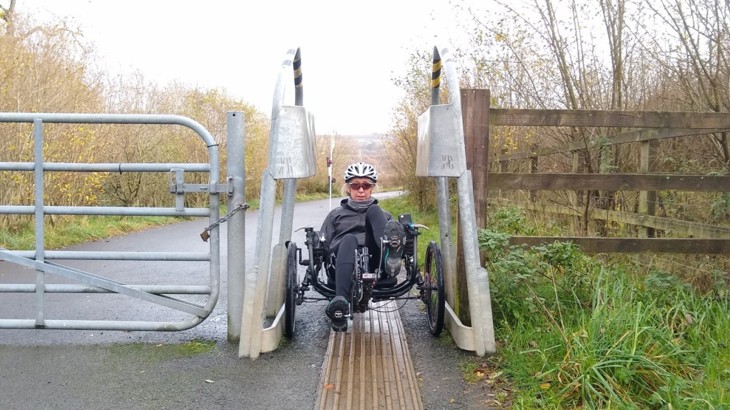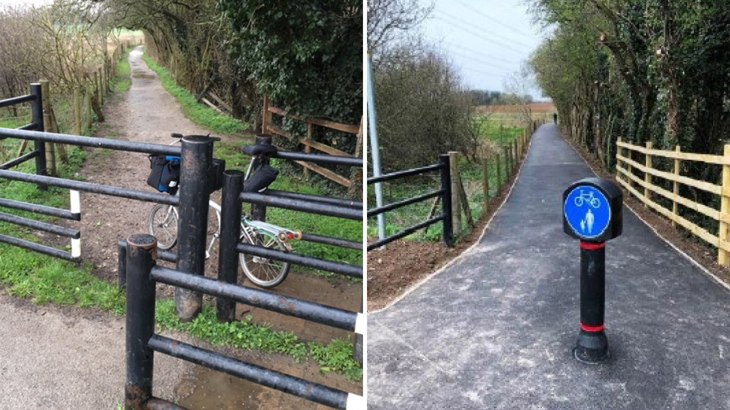One of our top priorities is to make the National Cycle Network accessible to everyone. Barriers on paths make it harder to use the routes, and for some people, they prevent access altogether. Read our position on access controls.

Barriers on the National Cycle Network can restrict access altogether for some legitimate users. Photo: Amanda Harris
Summary
- Walking, wheeling and cycling routes should always be fully accessible for legitimate users.
- The use of physical barriers and other restrictive access controls should never be used where they prevent access, especially where they discriminate against disabled people.
- Existing barriers should be removed or redesigned to ensure access is provided in line with the latest Government design guidance on walking and cycling infrastructure in all four UK nations, for example LTN 1/20 or other equivalent national accessibility standards.
Context
For many years in the UK, access control barriers have been installed on footways and on off-road walking, wheeling and cycling paths, including the National Cycle Network.
They are primarily used to stop people driving a vehicle or motorcycle on a path.
However, access controls are often ineffective. Motorbikes can be lifted over, through or pushed under a barrier.
Perimeter fencing can be vandalised to gain access. And it is also impractical to secure large, open areas, or ones with several entry points.
Many access barriers have the unintended effect of making paths inaccessible for legitimate users such as people using mobility scooters, wheelchairs, adaptive cycles, pushchairs or cargo bikes, or people riding horses.
Not only is this undesirable but local authorities are bound by the Equality Act 2010, which requires public sector authorities to comply with the Public Sector Equality Duty in carrying out their functions.
This includes making reasonable adjustments to the built environment to ensure infrastructure is accessible to all.
Barriers stop many people taking exercise, accessing green space and using routes to reach other essential services and amenities.
Whilst concerns about anti-social behaviour and crime may be cited as a justification for access controls, their installation can often create a space for those prone to anti-social behaviour to sit and congregate.
Access controls also create points where users must slow down, stop and in some cases dismount.
This can increase the risk of theft or harassment and make users feel unsafe.
Access controls are expensive to design, install and maintain. They also take up a lot of space.
What Sustrans thinks
We should always strive to make walking, wheeling and cycling routes fully accessible to everyone.
The use of physical barriers and other restrictive access controls should be avoided, especially where it would discriminate against disabled people and those with protected characteristics.
Barriers should also never be used where they prevent rightful access or passage.
Restrictive access controls, including those on the National Cycle Network, should be removed or redesigned to make sure they conform to LTN 1/20 or other equivalent national accessibility standards.
This position is in line with latest Government design guidance on walking and cycling infrastructure in all four UK nations, which explicitly states that restrictive access control measures should not be used.
We are aware of new barriers still being installed on routes.
It is imperative that national funding should never be used to fund access controls which are not fully inclusive through adequate inspection.
The illegal use of walking and cycling paths, including the National Cycle Network, by motorbikes, quad bikes and other motorised vehicles should be referred to the police and dealt with as a criminal matter.
Barrier redesign example
The stretch of path below is on National Route 15 at the entrance to the Grantham Canal.
The entrance to the path has been modified to comply with the Government’s LTN 1/20 guidance.
Legitimate users can access the path but vehicles are prevented from getting onto it.

A before and after image of National Route 15 near Grantham in Lincolnshire. We removed this restrictive barrier with funding from Highways England.
A single bollard or a row of bollards, with 1.5m gaps and with clear visibility of other users, can be effective if some form of access control is necessary to prevent people driving cars or vans onto a path.
All access points should be wide enough room to accommodate a cycle or mobility aid 1.2 metres wide and 2.8 metres long.
This will ensure it can be used by wheelchairs, mobility scooters, most cargo bikes, cycles with trailers, handcycles, and adapted cycles.
Detailed information on access to routes can be found in the Sustrans traffic-free routes and greenways design guide.
Read more about our work to make the National Cycle Network accessible to everyone.





